Retirement Risk: Inflation Risk
Apr 26, 2021 • Written by Paul Staib | Certified Financial Planner (CFP®), MBA, RICP®
Blog Home » Retirement Planning » Retirement Risk: Inflation Risk

Inflation is the tendency of prices to rise and money to lose purchasing power over time. It is often referred to as the “silent killer” regarding retirement planning. Inflation has a particularly negative effect on retirees because it chips away at retirement income in two primary ways:
- Increases the future cost of goods and services
- Potentially erodes the value of assets (your investment accounts) and income sources (social security and pension) planned on to meet those costs
For example, today a gallon of milk costs about $3.50. In 15 years, a 3% annual inflation rate would increase the price by more than 57% to $5.50! As inflation pushes the price of everything from groceries to new cars higher, it drives down the buying power of a dollar. That is why it is so important for your investments to outpace inflation. Even low inflation can damage purchasing power.
The likelihood of increasing future inflation makes it imperative that your retirement savings include investments with the potential to beat inflation – especially considering the longer retirement that today’s retirees can anticipate, as detailed in these posts: Retirement Planning: Longevity Risk and Estimating Your Life Expectancy.
This charts below illustrate the potential effect that various rates of inflation could have on the buying power of $50,000 over 25 years.
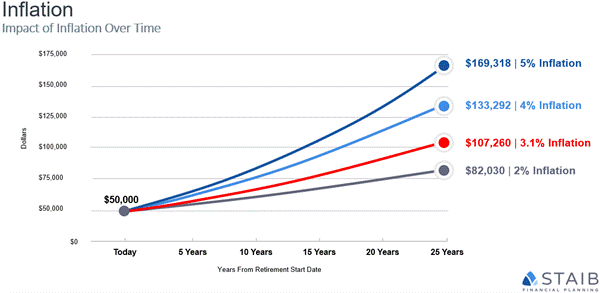
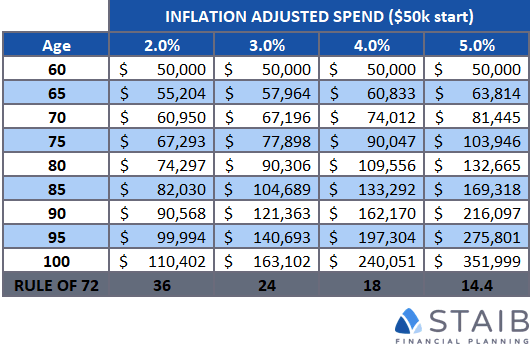
I’ve included the “rule of 72” at the bottom of the second diagram. The Rule of 72 is a quick, useful formula that is popularly used to estimate the number of years required to double the money at a given annual rate – it could be a rate of return or in this case, the rate of inflation. For example, using the 4% inflation rate results in 18 years (72/4), meaning at 4% inflation, your expenses would double about every 18 years. At 5% inflation, your expenses would double about every 14.4 years.
Historical Inflation Rates
In researching for this post, I discovered the below chart on inflationdata.com which graphs the inflation average by decade over the past century+. It helps put inflation into some longer-term perspective, while also highlights the significant range of results over time. There is certainly a risk of using the 3.1% long-term average for retirement planning purposes if we happen to experience a period of 1970s-like inflation in the near future!
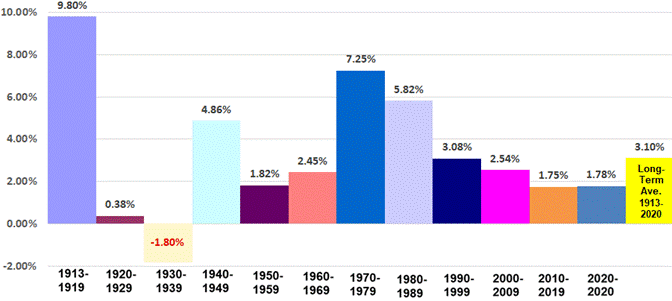
Higher Inflation Rates For Retirees
As illustrated in the graphic below, older Americans often experience a higher rate of inflation primarily because they spend a higher percentage of their total budget on health care, which is the fastest inflating category. The risk of rising healthcare costs is the subject of a separate post Retirement Risk: Health Care.
Since its beginning in December 1982, the consumer price index (CPI = inflation) for Americans 62 years of age and older (“CPI-E”) rose 6-10% faster than overall inflation (CPI-U). Again, this is primarily due to prices for medical care and housing increasing more rapidly than overall inflation.
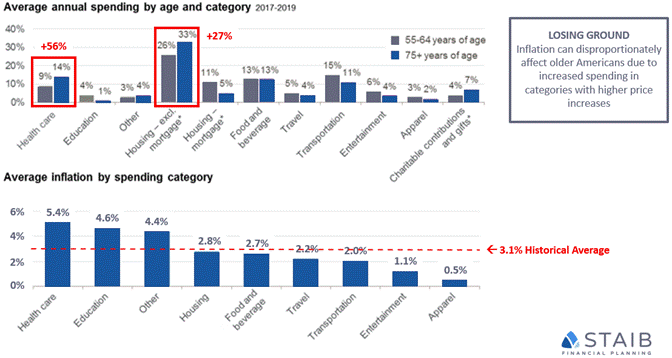
Managing Inflation Risk in Retirement Planning
There are several items for retirees to consider in reducing the risks posed by inflation.
Asset Allocation – Importance of Stocks
Perhaps most importantly, retirees should avoid the temptation to become too conservative too quickly with their allocation to stocks within their investment accounts. In pursuit of avoiding market volatility, there is a strong tendency for retirees to avoid stocks and over-allocate towards fixed income investments, or even cash. But by doing this they give up long-term growth potential and risk outliving their money (Longevity Risk), as stocks historically have been an excellent inflation hedge.
The diagram shows how various model asset allocations have fared compared with inflation and health care costs. A conservative portfolio – with a 20% stock allocation – has kept up with rising costs, but just barely. Greater exposure to equities may give a portfolio the “breathing room” necessary for long-term financial security.
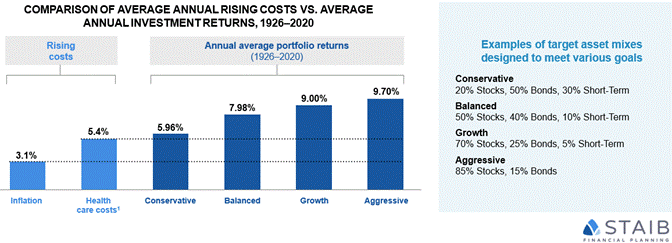
Delay Social Security
The benefit of delaying the start of social security benefits cannot be overstated for retirees concerned with inflation risk. Persons eligible for social security benefits may file for benefits as early as age 62; however, every year you delay your social security benefits, your benefits increase by ~8% each year up until age 70. If you delay your social security benefits from age 62 to age 70, that is a ~64% increase in social security benefits for life, in addition to cost-of-living adjustments (COLA) that SSA provides each year.
Other Considerations
Beyond your stock allocation and delaying social security, there are other methods to reduce inflation risk in retirement planning, including:
- build in sources of income – beyond Social Security – that have built in inflation protection, including:
- if applicable, defer an employer-sponsored retirement plan / pension which includes cost of living increases. Most private company plans do not provide COLA benefits, but these options do exist more within government-sponsored plans
- purchasing a life annuity with a cost-of-living rider. There are a limited number of products that offer this option, and they may be expensive due to the risk taken on by the carrier
- Under the safe withdrawal rate research, a 4% – 4.5% withdrawal based on the initial portfolio value can have cost of living increases and still be safe for a 30-year retirement period
- Working longer – either full or part-time – reduces the number of years that you will be subject to inflation while also providing wage income, which likely will rise with any inflationary pressures
- In addition to stocks, there are other asset classes which historically have been inflation hedges, including Treasury Inflation Protected Securities bonds (“TIPS”) and real estate. Including these within a well-diversified investment portfolio can help reduce inflation risk
In Closing…
With your potential retirement lasting 30+ years, it is vitally important to consider and plan for inflation risk. Due primarily to healthcare, inflation rates for retirees tends to exceed the average overall inflation rates. To mitigate the risk of higher prices over time, retirees need to ensure their planned retirement income exceeds – or at least keeps pace with – inflation.
Planning for inflation risk should include such considerations as: using a higher-than-average estimated inflation rate, considering a higher allocation towards stocks, deferring Social Security, and possibly purchasing an annuity(s) with cost-of-living adjustments.
Inflation risk is one of several major risks considered within a well-crafted comprehensive retirement plan. Refer to our Planning for Retirement Risks for additional information.

Paul Staib | Certified Financial Planner (CFP®), MBA, RICP®
Paul Staib, Certified Financial Planner (CFP®), RICP®, is an independent Flat Fee-Only financial planner. Staib Financial Planning, LLC provides comprehensive financial planning, retirement planning, and investment management services to help clients in all financial situations achieve their personal financial goals. Staib Financial Planning, LLC serves clients as a fiduciary and never earns a commission of any kind. Our offices are located in the south Denver metro area, enabling us to conveniently serve clients in Highlands Ranch, Littleton, Lone Tree, Aurora, Parker, Denver Tech Center, Centennial, Castle Pines and surrounding communities. We also offer our services virtually.
Read Next
Sources of Emergency Cash
• Written By Paul Staib | Certified Financial Planner (CFP®), MBA, RICP®
The current pandemic isn’t just a health crisis. For many households it’s a financial crisis as well. Unemployment claims and…
New Year’s Financial Resolutions: Get Your Finances in Shape
• Written By Paul Staib | Certified Financial Planner (CFP®), MBA, RICP®
Many people make resolutions on New Year’s Day. But no matter what your resolutions are, the key isn’t making the list, it’s…
